- ROYAL ARMS (or ROYAL COAT OF ARMS)
- The personal arms of a country’s monarch, in contemporary usage these are either taken in
a lightly amended form for governmental use, or form the greater arms of a nation state - see
‘state arms 1)’ under ‘arms’
(also ‘imperial arms’,
‘pavillion’ and
‘royal standard(s) 1)’).
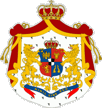
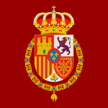
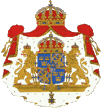
Royal Arms, Romania c. 1881 (fotw);
Royal Standard, Spain (fotw); Royal/Greater Coat of Arms, Sweden (fotw)
- ROYAL COMMAND FLAG (or BANNER)
- In Swedish usage, a banner of the royal arms (thus differing from the normal Swedish royal
standard) and flown in the presence of His Majesty the King when attending military functions,
or when acting in his honorary capacity as commander in chief of Sweden’s armed forces (see
also ‘banner 1)’ and
‘royal standard(s) 1)’).
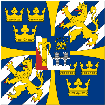

Royal Command Flag, Sweden (fotw): Royal Standard, Sweden (fotw)
- ROYAL BANNER
- 1) See ‘royal standard 1)’ and following note.
- 2) See ‘banner of the realm’.
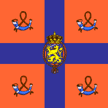

Royal Flag/Standard and Banner of the Realm, The Netherlands (fotw)
- ROYAL BROAD PENNANT
- See ‘broad pennant 4)’.

Queen’s Broad Pennant, Thailand (fotw)
- ROYAL COLOUR (or COLOR)
- See ‘colour 2)’ and
‘colours 2)’.
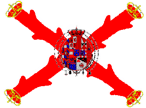
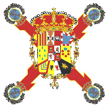
King’s Colour of the Royal Walloon Guards c.1734-1760, Spain (fotw); Queens Colour of the
Regiment of Chasseurs Isabel II 1841-1844, Spain (fotw)
- ROYAL CROWN
- See
‘crown 1)’.
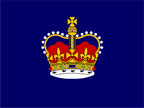
Flag of the Governor of Southern Rhodesia 1951 – 1965 (fotw)
- ROYAL CYPHER (or CIPHER)
- 1) The combination of letters (or a single letter) and numerals, usually ensigned with a
crown, that is the personal mark of a reigning, previous or former monarch (see also
‘ensigned’ and
‘personal flag 1)’).
2) See ‘monogram’.

Royal Cypher (for use in England) of HM King Charles III, UK (fotw)
- ROYAL DECREE
- In some systems of monarchy, the legal means by which a crowned head of state authorizes display of a flag or the amendment of an established design, and the equivalent of a US Executive Order, a Presidential Decree or a Royal Order in Council - see
‘executive order’,
‘presidential decree’, and
‘royal order in council 2)’ (also
‘flag law’).
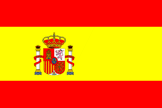

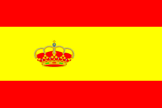
State/National Flag and Arms of Spain, plus the
Yacht Ensign of Spain 1875 - 1931 as authorized by Royal Decrees (fotw)
- ROYAL EMBLEM
- See ‘emblem, state, national or
royal’ under ‘emblem’.
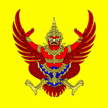

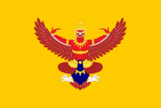
Royal Standards and Royal/National Emblem, Thailand (fotw)
- ROYAL FLAG(S)
- 1) See ‘royal standard(s) 1)’ and
‘royal standard(s) 2)’.
2) In the plural, a general heading under which all the flags, standards and banners relating
to the sovereign, or to the royal family, of any particular country or countries are listed (see also ‘imperial flag(s) 2)’).
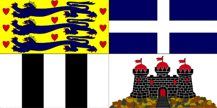
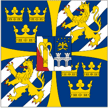

Standard of HRH Prince Philip 1921-2021, UK (fotw);
Royal Command Flag, Sweden (fotw);
Standard of the Raja Perempuan (or Wife of
the Ruler) of Perlis, Malaysia (fotw)
- ROYAL MASTHEAD PENNANT (or ROYAL PENNANT)
- A pennant of the same dimensions as the standard naval masthead pennant,
and flown in place of that pennant when the monarch is aboard ship – but see ‘broad
pennant 4)’ (also ‘masthead
pennant 1)’).

Royal Masthead Pennant, Norway (fotw)
Please note that as far as is known only Norway and Sweden currently fly a pennant exactly as described above.
- ROYAL ORDER IN COUNCIL
- 1) In current UK usage, the legal instrument by which the Monarch (upon
the advice of his/her privy council and under powers granted by statute law) authorizes
a usually (but not invariably) defaced red ensign – an order in council (see
also ‘civil ensign’ under
‘ensign’,
‘deface’,
‘flag law’,
‘red ensign 1)’ with its following note
‘royal proclamation’ and
‘warrant’.
2) In some other monarchical usage, the legal means by which a head of state confirms
or authorizes display of a flag, such as that which established the Driekler as the
national flag of the Netherlands in 1937 (see also
‘executive order’, ‘presidential decree’
and ‘royal decree’).

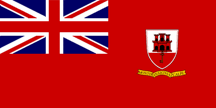
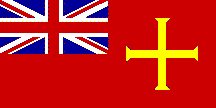
Civil Ensign of The Falklands Islands (fotw);
Civil Ensign of Gibraltar (fotw); Civil Ensign of Guernsey (fotw)
- ROYAL PLATE
- In British Royal Naval usage and some others, the royal equivalent of a flag disc
and used on boats in place of the appropriate royal standard when full ceremonial is
not required (see also ‘flag disc’ and ‘royal standard’ below).
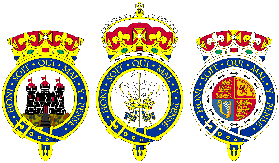
Plates of The Late Duke of Edinburgh; The Prince of Wales
and of Other Members of the Royal Family, UK (Graham Bartram)
Please note that in British Royal Navy usage a boat with His Majesty The
King on board never carries
a royal plate, but always flies the royal standard which requires full ceremonial.
- ROYAL PROCLAMATION
- In UK and some other monarchical usage, the means by which a royal decision is made public – see
‘royal decree’,
‘royal order in council 1)’ and
‘warrant’.

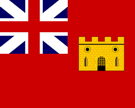
The Union Flag as Proclaimed in 1606, England/UK (fotw);
Customs Ensign as Proclaimed 1n 1694, England/UK (fotw)
- ROYAL STANDARD(S)
- 1) That flag, frequently a banner of arms, which signifies the presence
and/or authority of the monarch – but see note below (also
‘banner of arms’,
‘banner of the realm’,
‘distinguishing jack’,
‘imperial arms’,
‘imperial standard(s) 1)’,
‘imperial standard(s) 2)’,
‘personal flag 1)’,
‘presidential standard(s) 1)’,
‘royal command flag’ and
‘royal arms’.
- 2) In the plural, a term sometimes applied to the flags flown by other members
of a royal family – the queen’s, crown prince’s standard etc.
(see also ‘label 2)’).
- 3) In UK military usage, the official name of the state colour of the Grenadier
Guards – but see ‘state colour 2)’.
![[royal flags]](../images/v/vxt-d275.gif)
![[royal flags]](../images/v/vxt-d1728.gif)
![[royal flags]](../images/v/vxt-d4415.gif)
Royal Standards, UK ,
Thailand, and Spain
1761 - 1931 (fotw)
Please note that this term has been defined in 1) above according
to current UK usage (dating from the early 17th Century), but should, strictly speaking, only be applied to Royal Standards of the
heraldic pattern as detailed herein under
‘standard 3)’ and
‘standard 4)’, and the term “Royal Banner” employed where more
appropriate (see also ‘banner 1)’).

The Heraldic Standard of King Richard III of England 1483 - 1485 (fotw)
- ROYAL TRESSURE
- See ‘double-tressure fleury
counter fleury’.
![[Royal Banner of Scotland]](../images/v/vxt-d493.gif)
Royal Banner of Scotland (fotw)
- ROYAL WARRANT
- See ‘warrant’.
![[Jersey]](../images/v/vxt-d1386.gif)
Flag of Jersey Established by Royal Warrant (fotw)
- ROYAL YACHTING ASSOCIATION (or RYA) CROWN
- See ‘yachting crown’.
![[RYA burgee]](../images/v/vxt-d1309a.gif)
Official Duty Ensign of the Royal Yachting Association, UK (Graham Bartram)
- RUDDER STRIPES
- See ‘fin flash’.
![[Peruvian fin flash]](../images/v/vxt-d494.gif)
Rudder Stripes/Fin Flash of the Peruvian Air Force (fotw)
- RULE OF TINCTURE
- Most authoritative sources agree that good flag design should obey the
heraldic Rule of Tincture, and it is therefore stated in brief here: A colour
should never be placed on a colour or a metal (that is silver and gold in
heraldry and generally white and yellow in flags) on a metal. Metal may,
however, be placed on colour and colour on metal – see ‘tinctures’ (also ‘mixed
tinctures’).
![[Dorset, England]](../images/v/vxt-d3807.gif)
![[New Mexico]](../images/v/vxt-d5221.gif)
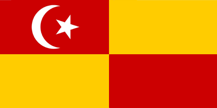
Flag of Dorset, England (fotw);
Flag of New Mexico, U.S. (fotw);
Flag of Selangor (fotw)
Please note, it is suggested that those deeply interested in this subject should consult a glossary or dictionary of heraldry for a more complete description.
- RULES OF ETIQUETTE
- The rules governing flag etiquette (or the protocol governing flag usage)
vary slightly from country to country, but are stated briefly in
Appendix II (see also
‘flag code’,
‘flag etiquette’,
‘flag law’ and
‘precedence’).
- RULES OF RESPECT
- The rules that govern respect for the national flag may be summed up in a
Golden Rule, which simply stated says that the national flag should be treated
with respect at all times. The particulars of what exactly this respect entails
vary in detail, legal status and extent, from country to country, however, the
general principles remain the same and a full list is given in
Appendix II.
- RUNE(S)
- A figure (or figures) taken from an ancient form of the written word which is (or has
been) largely (but not exclusively) used by various Nazi or neo-Nazi groups on their
uniforms and/or flag (see also ‘neo-nazi flags’ and ‘swastika’)
![[runes flag]](../images/v/vxt-d2963.gif)
![[runes flag]](../images/v/vxt-d2028.gif)
![[runes flag]](../images/v/vxt-d2027.gif)
Flag of the Viking Youth,
Germany (fotw); Flag of the
National Alliance c1970, USA (fotw);
Flag of Afrikaner Student Federation,
South Africa (fotw)
Please note that the so called “sig runes” on the SS badge were an invention (by an employee the badge makers) in 1932.
![[runes flag]](../images/v/vxt-d2030.gif)
Car Flag of Waffen-SS Commanders 1942-1945, Germany (fotw)
- RUNNING EYE
- See ‘becket’.
![[becket]](../images/v/vxt-d038a.gif)
- RUNNING EYE AND TOGGLE
- A traditional method, of hoisting a flag much favoured in European countries,
whereby a rope is sewn into the heading fitted with a wooden toggle at the top
and a loop, becket or eye splice at the bottom that fastens them to their opposites on
the halyard – toggle and becket or roped heading (see also
‘becket’,
‘eyesplice’,
‘hoistline’,
‘clip and grommet’,
and ‘toggle’).
![[becket]](../images/v/vxt-d038.gif)
- RUSE DE GUERRE
- The French term for a “trick of war” – see ‘false colours’.
- RYA CROWN
- See ‘yachting crown’.
![[RYA burgee]](../images/v/vxt-d1309a.gif)
Official Duty Ensign of the
Royal Yachting Association, UK (Graham Bartram)




























![[royal flags]](../images/v/vxt-d275.gif)
![[royal flags]](../images/v/vxt-d1728.gif)
![[royal flags]](../images/v/vxt-d4415.gif)

![[Royal Banner of Scotland]](../images/v/vxt-d493.gif)
![[Jersey]](../images/v/vxt-d1386.gif)
![[RYA burgee]](../images/v/vxt-d1309a.gif)
![[Peruvian fin flash]](../images/v/vxt-d494.gif)
![[Dorset, England]](../images/v/vxt-d3807.gif)
![[New Mexico]](../images/v/vxt-d5221.gif)

![[runes flag]](../images/v/vxt-d2963.gif)
![[runes flag]](../images/v/vxt-d2028.gif)
![[runes flag]](../images/v/vxt-d2027.gif)
![[runes flag]](../images/v/vxt-d2030.gif)
![[RYA burgee]](../images/v/vxt-d1309a.gif)

![[becket]](../images/v/vxt-d038a.gif)
![[becket]](../images/v/vxt-d038.gif)